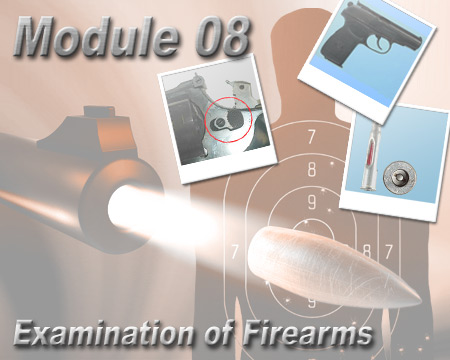
This is an archive page that is no longer being updated. It may contain outdated information and links may no longer function as originally intended.


This module discusses some of the most common types of firearms that an examiner might receive as evidence. The techniques presented can be adapted to any firearm. New models, variations of old models, and new designs are constantly introduced to the firearms marketplace, requiring the firearm examiner to continue to research and study new products.
Many people are exposed to the misuse of firearms through personal experience and misunderstandings. The firearm examiner must overcome misconceptions, and understand and be able to explain the type of firearm, its capabilities and limitations, and how this information correlates with the facts of the case.
The firearm examiner must be able to do the following:
In addition, having an understanding of how a particular firearm functions allows the examiner to determine what type of identifiable microscopic marks may be present on submitted bullets and cartridge cases.
The quality assurance officer or appointed individual will do an administrative and technical review of the results of the examination and attest that the protocols have been adhered to throughout.
At the conclusion of this module the student should be able to do the following:
| 14. | Knowledge of how to properly document evidence and analytical results (through notes, sketches, photography, reports, etc.) |
| 15. | Knowledge of the techniques and procedures used to properly mark evidence (when appropriate) |
| 38. | Knowledge of how and when to use various vises, clamps, and restraining devices |
| 39. | Knowledge of how and when to use gunsmithing tools |
| 43. | Knowledge of how and when to use borescopes |
| 44. | Knowledge of how and when to use bore lights |
| 70. | Knowledge of how and when to use spring trigger pull scales |
| 71. | Knowledge of how and when to use trigger pull weights |
| 76. | Knowledge of breech-loading firearms designs, including falling breechlocks, bolt actions, lever actions, pump actions, break open, semiautomatics (blowback, gas operated, recoil operated, etc.), revolvers--double and single action |
| 77. | Knowledge of firearms ignition systems: flintlock, percussion, rimfire, centerfire, caseless ammunition |
| 80. | Knowledge of sources of information regarding identification markings and serial numbering systems in firearms (including locations of serial numbers, part/assembly numbers, proof marks on firearms and the locations of hidden numbers) |
| 81. | Knowledge of the proper operation of the different types of firearms encountered in casework |
| 82. | Knowledge of the different materials that may be present in the bore of a firearm |
| 19. | Ability to understand and interpret technical data output from laboratory instruments |
| 21. | Ability to recognize discrepancies or inconsistencies in analytical findings and determine their cause and significance |
| 22. | Ability to recognize utility and limitations of reference collection/database programs |
| 23. | Ability to recognize the limitations of tests and interpretations |
| 24. | Ability to determine the design of the lockwork (firing system) in firearms |
| 25. | Ability to locate and identify the type (or types) of safety system(s) incorporated in a particular firearm |
| 26. | Ability to determine the design type, method of operation, and ignition of a submitted firearm |
| 27. | Ability to recognize when a firearm has been altered from its original design |
| 32. | Ability to examine, either directly or through the use of casts, the interior surface of a gun barrel to determine the method of rifling |
| 35. | Ability to evaluate the operability of each safety system, chambering method, and lockwork, recognize and explain any defects or failures in each of these systems and the consequences of any such defect or failure |
| 36. | Ability to compare firearm mechanisms with standards |
| 37. | Ability to recognize which parts of a firearm leave tool marks of forensic interest |